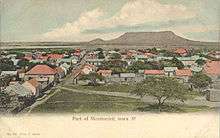Monte Cristi, Dominican Republic
| San Fernando de Monte Cristi | |
|---|---|
 San Fernando de Monte Cristi | |
| Coordinates: 19°51′0″N 71°39′0″W / 19.85000°N 71.65000°W | |
| Country |
|
| Province | Monte Cristi |
| Founded | 1506 |
| Municipality since | 1822 |
| Area[1] | |
| • Total | 455.5 km2 (175.9 sq mi) |
| Elevation[2] | 16 m (52 ft) |
| Population (2012)[3] | |
| • Total | 42,657 |
| • Density | 94/km2 (240/sq mi) |
| • Demonym | Montecristeño(a) |
| Distance to – Santo Domingo |
270 km |
| Municipal Districts |
0 |
| Climate | As |
San Fernando de Monte Cristi is the capital of Monte Cristi Province, Dominican Republic. It is located in the northwest region of the country in the coastal lowlands near the border with Haiti.
History
Monte Cristi was founded by Nicolás de Ovando in 1506 and populated in 1533 by Juan de Bolaños and 63 families from the Canary Islands. These migrated to various parts of the country afterwards leaving the town behind. It was later repopulated and became a very wealthy port in the mid-to-late 16th century.

In 1606, one hundred years after its founding, it was destroyed as retribution for doing business with pirates. In 1756 the city was rebuilt and again became a prosperous trading center, until the early 20th century. [4]
In 1895, was the site of the signing of el Manifiesto de Montecristi by Máximo Gómez and José Martí, at Máximo Gómez home located on Mella St. They sailed from "La Granja" beach, also in Montecristi, to Cuba to fight for its independence.
Climate
Monte Cristi has a tropical savanna climate with a pronounced dry season on summer, and an wet season on winter. It has an average temperature of 26.5 °C and an average annual rainfall of 700 mm. The average evaporation is 1800 mm. Precipitation is highest in the eastern part of the park where the winds collide with the Northern Range and discharge their waters. The same applies to the area of Manzanillo. The same winds hit the Central Cordillera and its prolongation Massif du Nord in Haiti. The effect is felt mainly in the foothills near Loma de Cabrera and Dajabón, but also, to a lesser extent, in Manzanillo.
Hurricanes and tropical storms have little effect on the area of Monte Cristi, however, can cause increased its rains and flooding in the Rio Yaque del Norte also affecting its mouth. The river brings sediment also affect reefs in the area. During the winter some cold fronts come from North America, with low temperatures and strong northerly winds. It is also common phenomenon swell: cold currents coming down from the Arctic seabed and emerge when they hit the island shelf.
(Köppen climate classification: As).[5]
| Month | Jan | Feb | Mar | Apr | May | Jun | Jul | Aug | Sep | Oct | Nov | Dec | Year |
|---|---|---|---|---|---|---|---|---|---|---|---|---|---|
| Record high °C (°F) | 34.2 (93.6) |
35.5 (95.9) |
36.0 (96.8) |
38.0 (100.4) |
36.0 (96.8) |
38.0 (100.4) |
39.0 (102.2) |
38.5 (101.3) |
39.0 (102.2) |
37.0 (98.6) |
37.0 (98.6) |
35.0 (95) |
39.0 (102.2) |
| Average high °C (°F) | 28.9 (84) |
29.4 (84.9) |
30.2 (86.4) |
30.5 (86.9) |
31.8 (89.2) |
33.3 (91.9) |
33.6 (92.5) |
33.8 (92.8) |
33.7 (92.7) |
32.7 (90.9) |
30.7 (87.3) |
29.2 (84.6) |
31.5 (88.7) |
| Daily mean °C (°F) | 24.1 (75.4) |
24.5 (76.1) |
25.1 (77.2) |
25.8 (78.4) |
27.0 (80.6) |
28.2 (82.8) |
28.4 (83.1) |
28.5 (83.3) |
28.3 (82.9) |
27.5 (81.5) |
25.9 (78.6) |
24.5 (76.1) |
26.5 (79.7) |
| Average low °C (°F) | 19.2 (66.6) |
19.6 (67.3) |
20.1 (68.2) |
21.1 (70) |
22.2 (72) |
23.0 (73.4) |
23.2 (73.8) |
23.3 (73.9) |
22.9 (73.2) |
22.4 (72.3) |
21.3 (70.3) |
19.8 (67.6) |
21.5 (70.7) |
| Record low °C (°F) | 14.0 (57.2) |
15.0 (59) |
14.7 (58.5) |
16.0 (60.8) |
17.0 (62.6) |
19.0 (66.2) |
20.0 (68) |
19.8 (67.6) |
18.0 (64.4) |
18.0 (64.4) |
16.2 (61.2) |
14.0 (57.2) |
14.0 (57.2) |
| Average rainfall mm (inches) | 73.8 (2.906) |
47.3 (1.862) |
47.7 (1.878) |
59.0 (2.323) |
59.8 (2.354) |
40.1 (1.579) |
21.5 (0.846) |
28.1 (1.106) |
34.8 (1.37) |
67.7 (2.665) |
108.2 (4.26) |
84.1 (3.311) |
672.1 (26.461) |
| Average rainy days (≥ 1.0 mm) | 5.0 | 3.7 | 3.2 | 4.4 | 5.4 | 3.2 | 2.1 | 2.8 | 3.7 | 5.7 | 6.6 | 6.5 | 52.3 |
| Average relative humidity (%) | 79.3 | 78.0 | 76.7 | 77.4 | 78.7 | 75.9 | 73.1 | 73.6 | 74.8 | 76.7 | 77.3 | 79.2 | 76.7 |
| Source: NOAA[6] | |||||||||||||
See also
References
- ↑ Superficies a nivel de municipios, Oficina Nacional de Estadistica
- ↑ De la Fuente, Santiago (1976). Geografía Dominicana (in Spanish). Santo Domingo, Dominican Republic: Editora Colegial Quisqueyana.
- ↑ Censo 2012 de Población y Vivienda,Oficina Nacional de Estadistica
- ↑ "Montecristi". Encyclopædia Britannica. Retrieved 2007-08-02.
- ↑ "Monte Cristi Climate & Temperature". Climatemps.com. Retrieved 27 December 2014.
- ↑ "Monte Cristi Climate Normals 1961–1990". National Oceanic and Atmospheric Administration. Retrieved March 23, 2015.
Coordinates: 19°52′N 71°39′W / 19.867°N 71.650°W